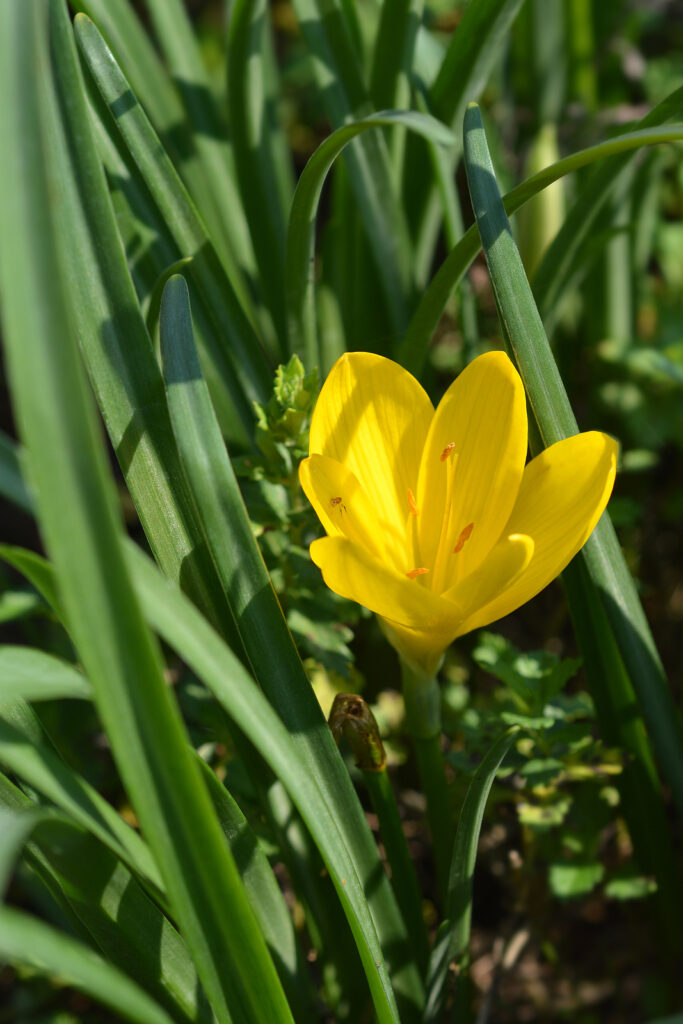Sternbergia, often known as autumn daffodil or winter daffodil, is a delightful bulbous plant that blooms in the fall, bringing bright yellow flowers that resemble crocuses.
Although Sternbergia species are commonly know as autumn daffodils, at fist glance their flowers look more like crocuses. The flowers usually are funnel to goblet shaped, although some species bear more star-shaped blooms. The flowers consist of six petal-like tepals.
Unlike crocuses, which belong in the iris family and have three stamens, the flowers of Sternbergia species have six stamens. And while crocuses grow from corms, Sternbergia species grow from tunicate bulbs. The basal leaves are linear to strap shaped and appear with or just after the flowers. About eight species belong to the genus, and they are native from southern Europe and Turkey to Central Asia.
Sternbergai leaves are narrow, 6 to 12-inches long. Leaves appear in fall simultaneously with flowers and remain green for several months after blooms have gone. Golden yellow, 1 ½-in. flowers resemble large crocuses on 6 to 9-inch stems and provide a pleasant autumn surprise in borders or rock gardens, near pools. Sternbergia dies down to the ground in spring.
Sternbergia belongs to the Amaryllidaceae family.
How to Use Sternbergia in the Garden
- Borders and Edging: Use Sternbergia to brighten up fall borders. They pair well with evergreen shrubs or plants with darker foliage to enhance their bright yellow blooms.
- Rock Gardens: Since Sternbergia thrives in well-draining soils, they are ideal for rock gardens or dry, sunny areas where other plants may struggle.
- Under Trees or Shrubs: Plant them under deciduous trees or shrubs that lose their leaves in the fall. This allows Sternbergia to shine when the trees are bare.
- Containers: Sternbergia also does well in pots or containers. Just make sure to use a well-draining potting mix and avoid overwatering.
- Naturalizing: Over time, Sternbergia will spread and create a naturalized look in sunny meadows, woodland edges, or grassy areas. They work well for a more natural, wild garden aesthetic.
- Cut flower: Sternbergia is a beautiful cut flower.

Where to Plant Sternbergia
Select a site in full to partial shade with very well drained, average to rich soil. Well-drained soil is especially important in winter; a spot in raised bed or rock garden provides the conditions these plants prefer.
In colder climates, grow in pots. Place four or five bulbs in a pot, setting them 2 in. deep. Don’t be in a hurry to repot, since plants bloom better when pot-bound.
- Light: Sternbergia thrives in full sun but can tolerate partial shade.
- Soil: Well-draining soil is essential. They prefer sandy or loamy soils with good drainage, as the bulbs can rot in waterlogged conditions.
- pH: Neutral to slightly alkaline soil is ideal.
Sternbergia Planting Time
- Plant the bulbs in late summer or early fall, as Sternbergia blooms in the autumn. Plant bulbs as soon as they become available (in August or September).
- Plant the bulbs in late summer—for best results as early you can obtain them—setting them at depth of 6 inches. Plant S. candida 8 inches deep. Be sure to loosen the soil several inches below this depth to encourage the roots to spread out. Once planted, sternbergias are best left undisturbed. They will form large clumps with time, and plants also self-sow.
Sternbergia Planting Depth and Spacing
- Plant the bulbs about 3-4 inches (7-10 cm) deep.
- Space the bulbs about 4-6 inches (10-15 cm) apart to give them room to grow and multiply over time.
Sternbergia Watering
- Water the bulbs well after planting to help establish root growth. After that, water sparingly; Sternbergia is drought-tolerant once established and prefers dry conditions during its dormant summer period.
Sternbergia Care
- Apply a light fertilizer in early spring to encourage healthy growth.
- Once the leaves die back in late spring, allow the plant to go dormant. Avoid watering during the summer dormancy period.
- If winters are severe, add a layer of mulch for extra protection, though they are hardy in most areas.
Sternbergia Propagation
- Propagate by seeds or by separating the offsets just as the leaves die down.
- The bulbs will multiply over time. You can divide the clumps every few years in summer when they are dormant to spread them in the garden.
- Clumps bloom well only after 2 or 3 years; wait at least 6 to 8 years before dividing.
Sternbergia Varieties to Grow
- Sternbergia candida: a late-winter—to spring-blooming species that is 4 to 8 inches tall. Bears fragrant, funnel- to goblet-shaped, 2-inch-wide white flowers that appear shortly after the leaves. Zones 8 to 10.
- S. lutea: called autumn daffodil, winter daffodil. A fall-blooming 6-inch-tall species bearing golden yellow, goblet-shaped, 1 ½-inch-wide flowers in fall. The narrowly lance-shaped leaves appear with the flowers and last through the winter. Zones 6 to 9.
- S. sicula: a fall-blooming 3-inch-tall species. Bears ½-to 1 ½-inch-wide flowers that are star shaped and dark yellow in color. Zones 6 to 9.


